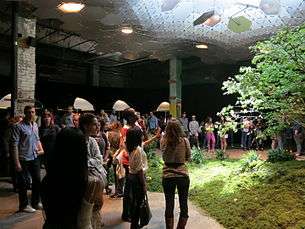Lowline (park)
Coordinates: 40°43′05″N 73°59′13″W / 40.717989°N 73.987025°W
| Lowline | |
|---|---|
|
Artist's concept of the proposed park design | |
| Type | Subterranean urban park |
| Location | Manhattan, New York City (adjacent to Essex Street station) |
| Status | Proposed |
| Website | http://thelowline.org/ |


The Lowline, formally known as the Delancey Underground,[1] is a proposal for the world's first underground park in the New York City borough of Manhattan that would be located under the eastbound roadway of Delancey Street on the Lower East Side, adjacent to the Essex Street station (J M Z trains). Co-founders James Ramsey and Dan Barasch[1] have suggested natural light would be directed below ground using fiber optics—described in the proposed plan as "remote skylights"[2]—to provide an area in which trees and grass could be grown beneath the city streets.[3] Light collectors would be placed at ground level, with suggested locations, including the median on Delancey Street. Artificial lighting would be used to supplement the redirect sunlight, and at night and when the sun is obscured by clouds. The area, with ceilings 20 feet (6.1 m) high, extends three blocks east from Essex Street to Clinton Street and was used until 1948 as a station and balloon loop for streetcars crossing the Williamsburg Bridge to and from Brooklyn.[4][5] R. Boykin Curry IV is the third urban entrepreneur behind the proposal.[1]
History
The large trolley terminal that is the site has sat unused for more than 60 years.[1] The project was first proposed in 2011 and quickly generated widespread media attention.[6]
In 2012, the project raised over $150,000 from 3,300 backers on Kickstarter to create a full-scale exhibition of the solar lighting technology.[7] The project was named by Mashable as one of the top Kickstarter projects of that year.[8] In September 2012 an installation was opened on the Lower East Side to promote the project; titled "Imagining the Lowline," it consisted of a 30-foot wide aluminum solar canopy distributing natural sunlight onto a live cultivated landscape "park." The exhibit saw over 11,000 visitors and featured design talks, school visits, weekend street fairs and a political event. The executive producer of the exhibit was Robyn Shapiro and the industrial designer was Ed Jacobs with support from Brandt Graves.[9]
Support
The project has been endorsed by politicians and organizations such as US Senator Kirsten Gillibrand, former NY State Assembly Speaker Sheldon Silver, Manhattan Community Board 3, and the Lower East Side business improvement district. Barasch and Ramsey worked with HR&A Advisors and Arup to complete a feasibility study outlining the cost to build the park, long-term business model and community benefits. The findings were released to various news outlets such as the Wall Street Journal.[10] and New York magazine.[1]The Lowline was shown in Time magazine's 25 best inventions of 2015 (Dec7 issue). The underground area borders the 1,650,000 square feet (153,000 m2) Seward Park Urban Renewal Area, for which the Economic Development Corporation has issued an RFP. The Lowline site is not included in the RFP as it is owned by the Metropolitan Transportation Authority. The Lowline team is currently working with the MTA, who will not contribute any funds,[1] and the New York City Council to gain access to build on site, as well as continuing with their fundraising efforts.
See also
References
- 1 2 3 4 5 6 "The Low Line". New York magazine. Sep 26, 2011.
- ↑ "HuffPost Arts Interviews James Ramsey On His Astounding Plans For A NY Underground Park (PHOTOS) " Huffington Post, 23 February 2012.
- ↑ McCarthy, Megan. "Episode 6: James Ramsey of Low Line – Bringing the Underground to Light". New York Observer.
- ↑ Foderaro, Lisa W. "Inspired by High Line, Park Is Envisioned With Sights Set Low", The New York Times, November 21, 2011. Accessed November 21, 2011.
- ↑ Plans for Delancey Underground presented to Community Board 3
- ↑ Official website
- ↑ LowLine Creators Reach Initial Fundraising Goal On Kickstarter
- ↑ Kickass Kickstarter Projects
- ↑ The Lowline, New York's Revolutionary Underground Park, Says Let There Be Light | Co.Exist: World changing ideas and innovation
- ↑ the Wall Street Journal
External links
Project:
- Official website
- Article on project with pictures
- A Look Inside the Lowline, New York City’s First Underground Park Bloomberg Business 2015
Existing space:
- Pictures
- Delancey Street/ Essex Street Complex
- Williamsburg Bridge Railway terminal
- Track map of site
